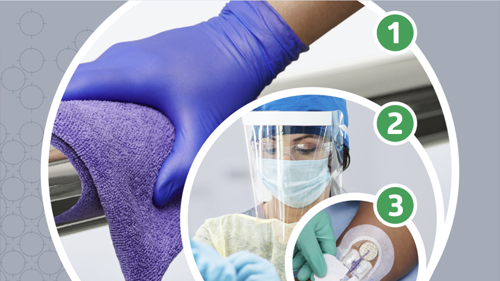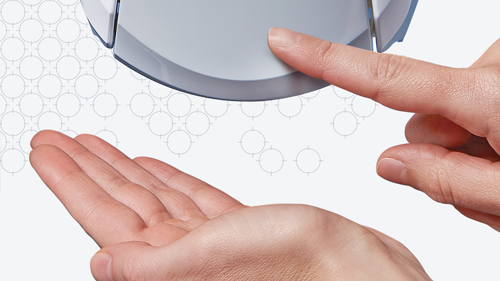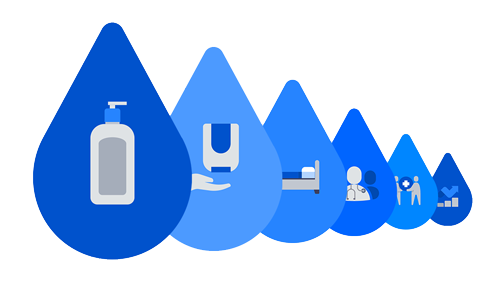How to build a business case for your hand hygiene program
Reduce excess costs and penalties from HAIs by increasing compliance rates.

Every day, caregivers in healthcare facilities strive to provide high-quality care for patients and residents. Studies show that consistent hand hygiene is the most important and least expensive way to reduce healthcare-associated infections (HAIs) and the spread of antimicrobial resistance.1 Yet this simple task has an average compliance rate of less than 50%.2 It’s time to build the financial case for an effective hand hygiene program.
Hand hygiene budget vs. HAI costs
How much do you spend per year on hand hygiene products? Each use of an alcohol-based sanitizer costs only ½ to 1 cent.3 To put these expenses into perspective, consider comparing your budget for these products with estimated excess hospital costs resulting from HAIs.
The excess costs associated with only four or five HAIs of average severity may equal the entire annual budget for hand hygiene products used in inpatient care areas. Just one severe surgical site infection, bloodstream infection or MRSA case may cost the hospital more than the entire annual budget for antiseptic agents used for hand hygiene.4
Hand hygiene noncompliance: Costs and lost revenue
Rates of MRSA and other multidrug-resistant organisms (MDROs) are on the rise. The following study shows the effect of noncompliance on excess costs.
At Duke University Medical Center, a 750-bed tertiary medical center in Durham, N.C., a study was conducted to estimate the MRSA-related cost of a single episode of hand hygiene noncompliance by a caregiver during patient care. Costs ranged from approximately $2 (when a patient’s MRSA colonization or infection status was unknown) to more than $50 per episode (when healthcare workers did not wash their hands after contact with a patient who was a MRSA carrier).
“You might switch to a $12 dressing, but if everyone doesn’t do this simple action that only costs pennies, the more expensive dressings aren’t going to help patient care.”

Angela Zuick
Medline Director of Clinical Services
On the basis of these estimates:
- Improved hand hygiene compliance among caregivers in a 200-bed hospital by as little as 1% would prevent approximately one episode of infection due to MRSA and would result in MRSA prevention-associated cost savings of almost $40,000 per year
- If the same hospital improved hand hygiene compliance by 5%, approximately four MRSA infections would be prevented and the cost savings would approach $200,0005
A project to estimate the excess cost associated with 10 HAIs was conducted by NORC at the University of Chicago in partnership with Emory University, on behalf of the Agency for Healthcare Research and Quality (AHRQ). Here were their findings:
- Average cost of an HAI episode is approximately $31,000
- Least expensive infectious HAI is catheter-associated urinary tract infection at $13,793
- Most expensive HAI is central line-associated bloodstream infection at $48,1086
Keep in mind the potential ripple effect of an HAI:
- Longer length of stay for a patient
- Bed unavailability for a new patient
- 30-day readmission
- Lack of payment from the Centers for Medicare & Medicaid Services (CMS)
In fact, this year the federal government is penalizing 764 hospitals a 1% reduction in Medicare payments over 12 months for having the highest numbers of patient infections and potentially avoidable complications.7 Long-term care facilities that don’t meet infection control requirements are cited with F-tags and could be looking at CMS fines of up to $20,000.8
$31,000
is the average approximate cost of an HAI episode6
Hand hygiene compliance: Costs and benefits
C. difficile is responsible for more than 15,000 deaths and $5 billion in direct healthcare costs annually. A study was conducted to identify the most cost-effective infection control strategy for reducing hospital-onset C. diff.
In a simulated 200-bed acute care facility, the five main interventions that proved to be most effective in reducing the infection were:
- Daily cleaning
- Healthcare worker hand hygiene
- Patient hand hygiene
- Terminal cleaning
- Reduced intra-hospital transfers
While daily cleaning was the most effective intervention, hand hygiene is the second most important precaution in preventing double-digit hospital-onset C. diff infections.
Findings showed:
- Among all the interventions modeled, healthcare worker hand hygiene is the most well studied and has been shown to be cost saving
- Chen et al reported that every dollar spent on their hospital’s four-year hand hygiene program resulted in a $32.73 return on investment (2018 USD)
In addition, hand hygiene needed to account for less than 1% of the concurrent decline in HAIs at their institution to be cost saving.9
Effective products and monitoring increase compliance
How do you increase hand hygiene compliance? Start with today’s innovative products to address barriers and provide results. These include:
- Alcohol-based sanitizers with moisturizers that are tested and approved to kill 99.99% of germs on hands while reducing dry skin
- Exam gloves with beneficial colloidal oatmeal coatings that soothe and restore moisture to skin
- Electronic hand hygiene monitoring systems that are accurate, easy to set up and use, and affordable
Healthcare facility leaders should take into account that by purchasing more effective or more acceptable hand hygiene products to improve hand hygiene practices, they will help avoid HAIs. Preventing only a limited number of additional HAIs per year will lead to savings that will exceed any incremental costs of improved hand hygiene products.4
Key takeaway
Consistent hand hygiene compliance is the simplest and most cost-effective way to reduce HAIs. Increase executive buy-in for high-quality hand hygiene products and compliance monitoring devices by showing how noncompliance increases excess costs while compliance lowers excess costs and increases revenue. And most importantly, keeps everyone safe.
References:
- Mathur, Purva. Hand hygiene: Back to the basics of infection control. Indian J Med Res. 2011 Nov; 134(5): 611–620. Available at: https://www.ncbi.nlm.nih.gov/pmc/articles/PMC3249958/#:~:text=Go%20to%3A-,Importance%20of%20hand%20hygiene,%E2%80%933%2C20%E2%80%9323
- CDC. Hand Hygiene in Healthcare Settings. Available at: https://www.cdc.gov/handhygiene/index.html. Accessed February 28, 2022.
- Data on file.
- CDC. Guideline for hand hygiene in health-care settings. October 25, 2002/Vol. 51 / No. RR-16. Available at: https://www.cdc.gov/mmwr/PDF/rr/rr5116.pdf
- Cummings, MD, Keith L.; Andersen, MD, Deverick J.; Kaye, MD, Keith S. Hand Hygiene Noncompliance and the Cost of Hospital‐Acquired Methicillin‐Resistant Staphylococcus aureus Infection. Infect Control Hosp Epidemiol 2010; 31:357-364.
- AHRQ. Final Report: Estimating the Additional Hospital Inpatient Cost and Mortality Associated with Selected Hospital-Acquired Conditions. November 2017. Available at: https://www.ahrq.gov/sites/default/files/publications2/files/hac-cost-report2017.pdf
- Rau, Jordan. Health Care Paradox: Medicare Penalizes Dozens of Hospitals It Also Gives Five Stars. Kaiser Healthcare News, February 8, 2022. Available at: https://khn.org/news/article/health-care-paradox-medicare-penalizes-dozens-of-hospitals-it-also-gives-five-stars/
- Brown, Danielle. Providers face fines of up to $20K for infection control deficiencies, CMS says. McKnight’s Long-Term Care News, June 2, 2020. Available at: https://www.mcknights.com/news/providers-face-fines-up-to-20k-for-infection-control-deficiencies-cms-says/
- Barker, MD, PhD, Anna K.; Scaria, Elizabeth; Safdar, Nasia, MD, PhD. Evaluation of the Cost-Effectiveness of Infection Control Strategies to Reduce Hospital-Onset Clostridioides difficile Infection. JAMA Netw Open. 2020;3(8):e2012522. doi:10.1001/jamanetworkopen.2020.12522. Available at: Evaluation of the Cost-effectiveness of Infection Control Strategies to Reduce Hospital-Onset Clostridioides difficile Infection | Gastroenterology | JAMA Network Open | JAMA Network




